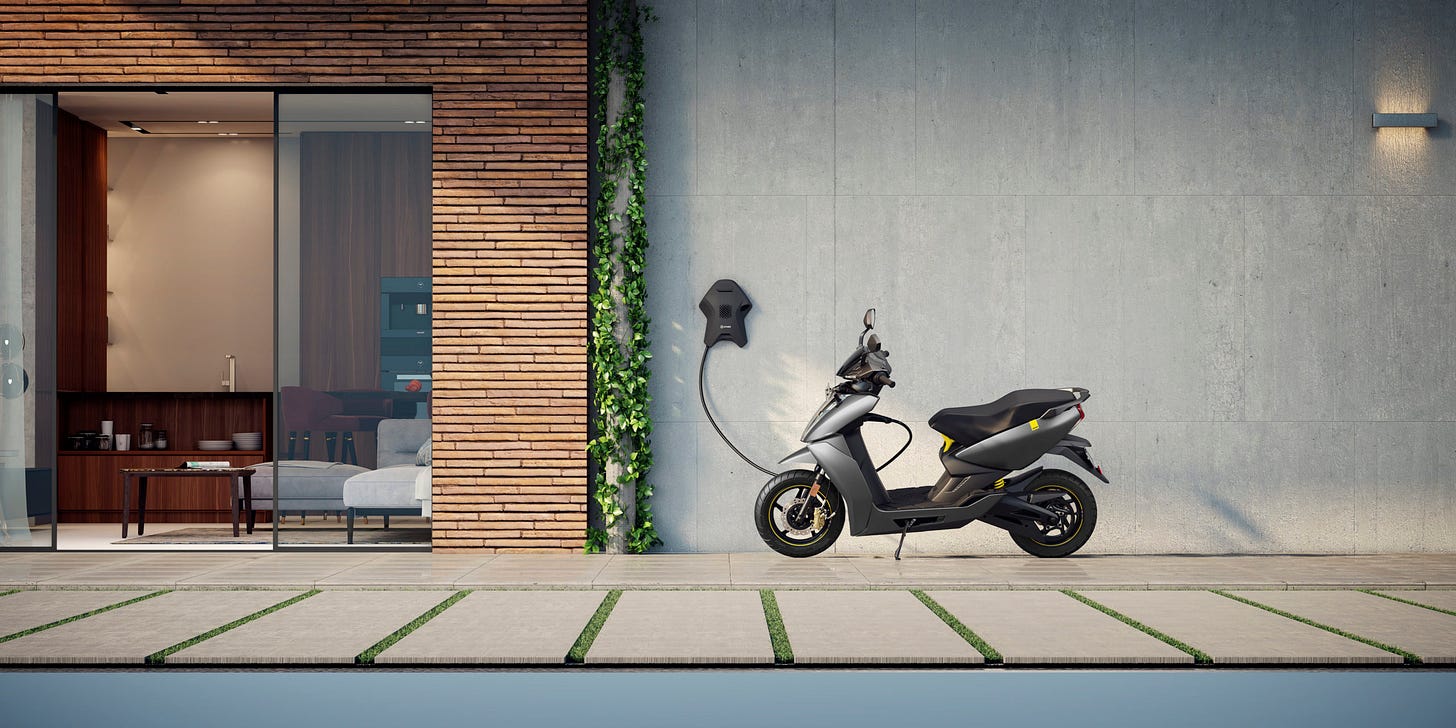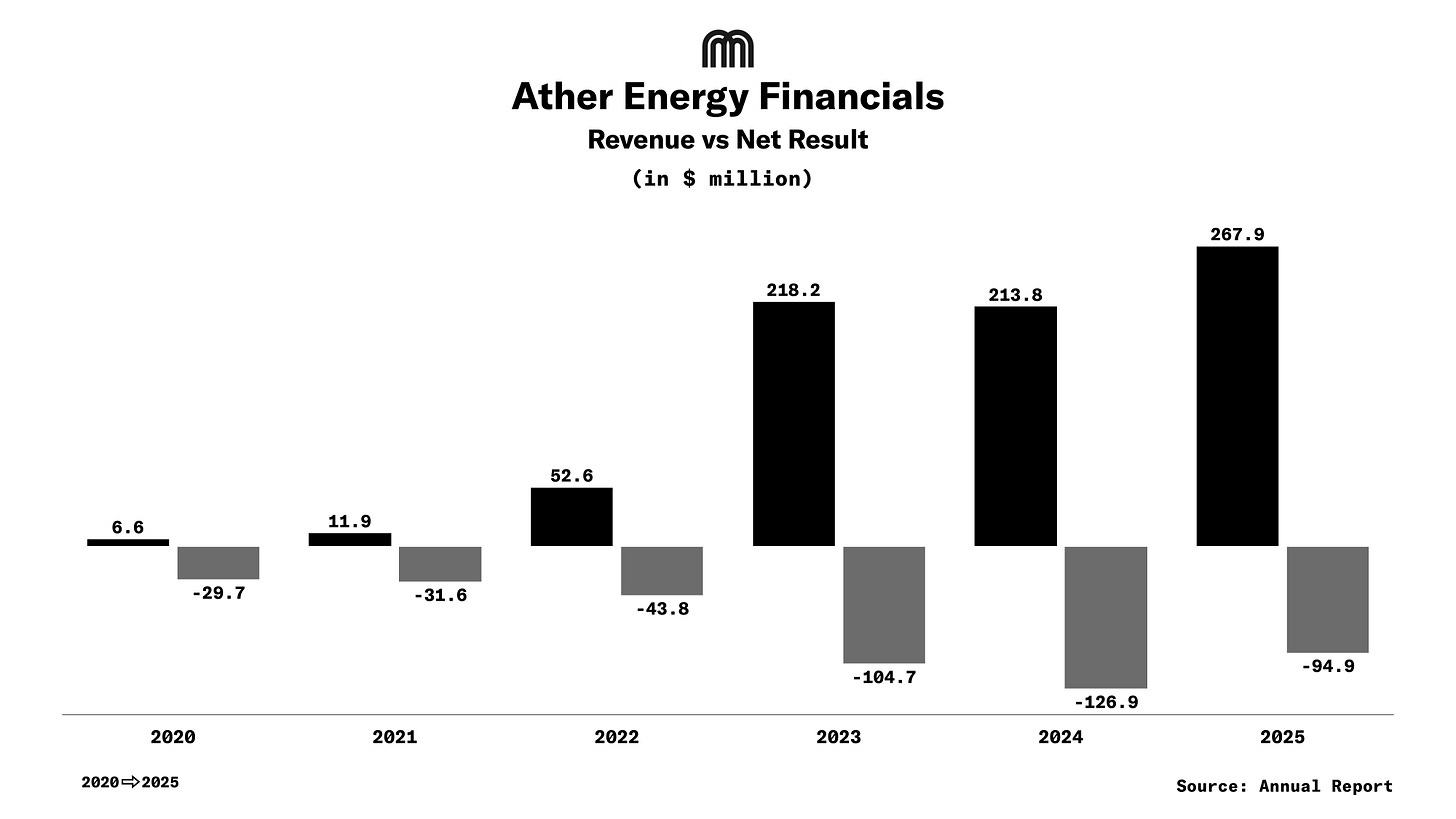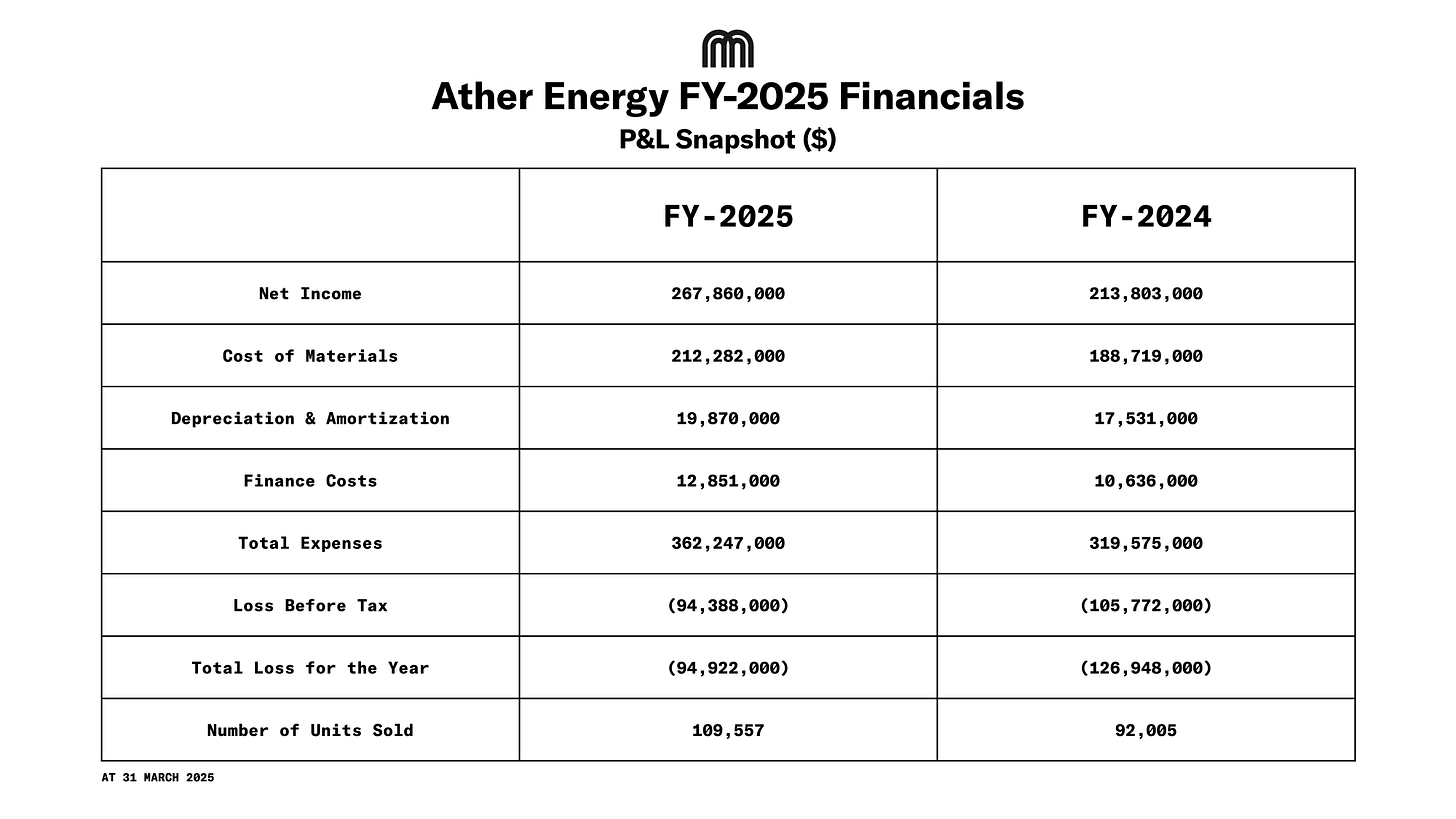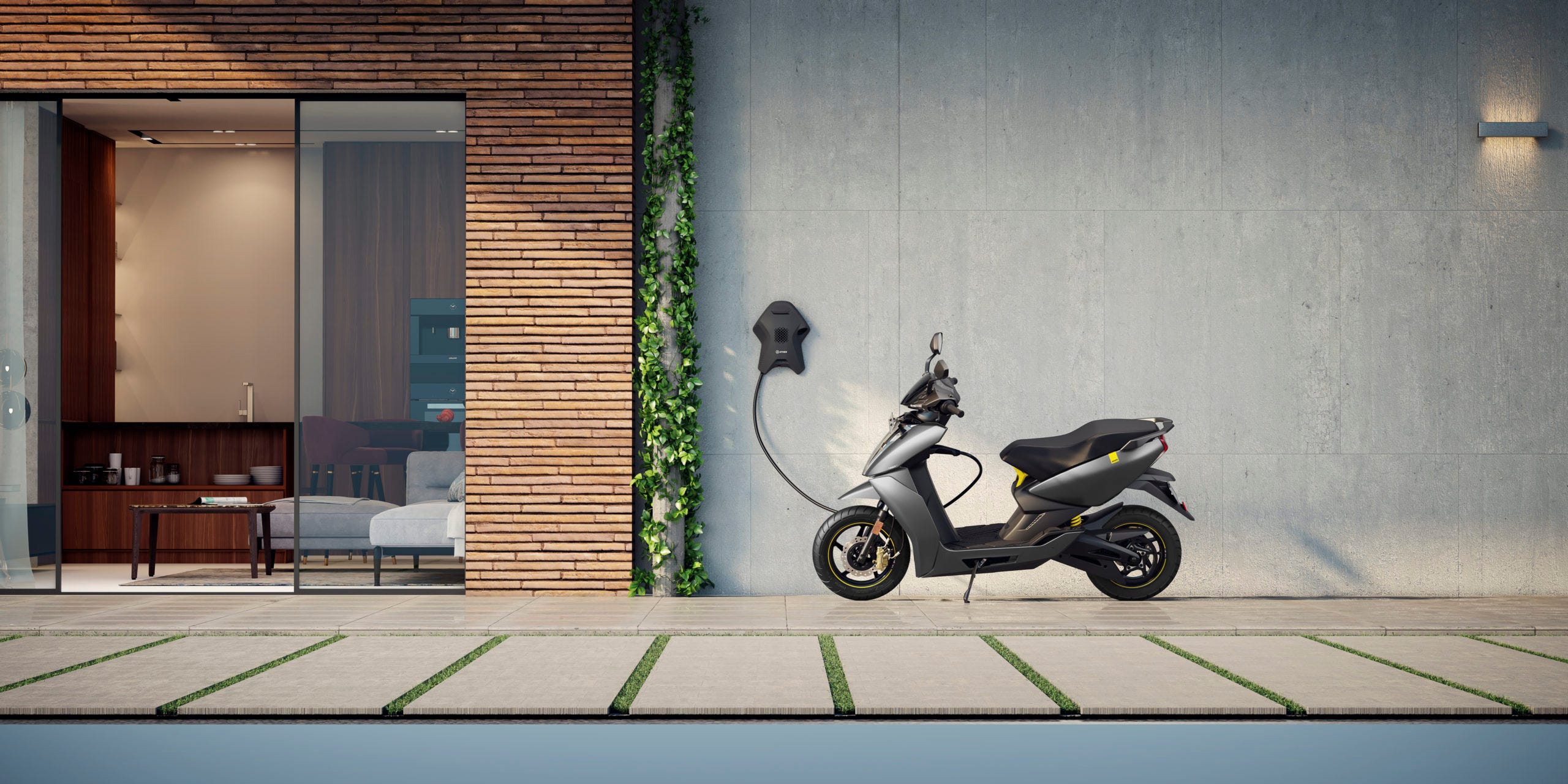Contents
- Introduction
- Financial Performance (FY2024–2025)
- Chart: Revenue vs Net Result (FY 2020 - FY 2025)
- P&L Snapshot
- Cost Structure Breakdown
- Chart: Expense Analysis
- IPO Performance
- Chart: YTD Stock Performance
- Cash Position & Balance Sheet
- Balance Sheet Snapshot
- 2025 Outlook
- Strengths and Challenges
- Conclusion
Introduction

Ather Energy was founded in 2013 by IIT-Chennai graduates Tarun Mehta and Swapnil Jain to address the lack of high-quality electric vehicles in India. Starting from a clean-sheet design, they developed the country's first smart electric scooter and launched the Ather 450 in 2018, featuring a connected dashboard and over-the-air updates. With early backing from the founders of Flipkart and Hero MotoCorp, Ather focused on building a vertically integrated EV platform that now includes its own charging network (Ather Grid) and retail experience (Ather Space).
Today, Ather positions itself at the premium end of India's two-wheeler EV market with its flagship product line, the Ather 450X, and the country's largest fast-charging infrastructure. In August 2024, the company transitioned to a public limited structure in preparation for its initial public offering. The IPO in May 2025 raised $305.3 million (₹26,260 million). During the same period, Ather acquired 100 acres of land in Maharashtra for $11.5 million (₹955 million) to scale manufacturing capacity and converted all outstanding preference shares into equity, marking a new phase in its public-market journey.
Also, check out our recent webinar with McKinsey on the electric two-wheeler market.
Financial Performance (FY2024–2025)

Ather’s revenue surged 28.6% YoY to $262m, outpacing expense growth of 16.6%. Total expenses reached $349.4m (FY2024: $308.9m), reflecting disciplined cost management amid aggressive expansion. However, net losses deepened to $136m (FY2024: $128.6m), as material costs ($212.3m) and debt-driven finance costs ($12.9m) offset revenue gains. Ather Energy demonstrated robust revenue growth but continued to face profitability challenges:
- Revenue: $262m (FY2024: $209.6m), a 28.6% year-on-year increase driven by higher sales volumes and market expansion.
- Total Income: $267.9m, including $5.8m from investments and interest income.
- Total Expenses: $349.4 million (FY2024: $308.9m), up 13.10% YoY.
- Slower expense growth relative to revenue highlighted improved cost discipline.
- Net Loss: $94.92m, a 5% improvement from FY2024 ($128.57m previous year). This reduction stemmed from revenue scaling and eliminating the cost of exceptional items.
- By March 2024, the company spent $18.85m (₹1,578m) refunding customers for off-board chargers and ₹168 million for battery incentive adjustments. By March 2025, $17.6m (₹1,473m) had already been refunded. $1.25m (₹105m) is still pending but kept in a secure bank account. The company will get this amount back after completing the refunds and submitting proof.
- Additionally, the company paid $2m (₹168m) to the government (MHI) to adjust for differences in battery capacity that affected the incentive amount.
- Loss Per Equity Share: $0.37 (basic), improved by 31.9% after adjustments for bonus issues and share subdivisions.

Cost Structure Breakdown
- Materials Consumed: $212.3m (59% of total expenses).
- Employee Benefits: $47.9 million (13.2%).
- Depreciation & Amortization: $19.9 million (5.5%).
- Other Expenses: $63.5 million (17.5%), including warranty costs ($7.0 million), logistics, and R&D.
- Finance Costs: $12.9 million (3.5%).

Ather’s financial strain stems from its cost anatomy. Materials consumed $212.3m (59% of expenses), employee benefits ($48 million) and depreciation ($20 million) followed, while logistics, warranties ($7 million), and R&D swelled "other expenses" to $64 million. Even with cost discipline, the math remains unforgiving: every dollar of revenue costs Ather $1.33 to earn.
Ather IPO Performance

In April 2025, the company launched an IPO of around 92.87 million shares. About 81.82 million shares were newly issued to raise fresh funds, including 100,000 shares offered to employees at a discounted price of $3.38 (₹291). Most shares were priced at $3.73 (₹321), raising $305.3m (₹26,260m). Another 11.05 million shares were sold by existing shareholders, bringing in an additional $41.22m (₹3,548m). The company’s shares were listed on the NSE and BSE on 6 May 2025.
Cash Position & Balance Sheet
Cash Flow (FY2025):
- Operating Activities: $83.8 million outflow, strained by inventory buildup ($14.9m increase) and receivables ($1.2m increase).
- Investing Activities: $44.0 million outflow, primarily for manufacturing facilities ($39.4m Capex).
- Financing Activities: $81.7 million inflow, driven by debt issuance ($47.6 million).

Balance Sheet (March 31, 2025):
- Total Assets: $244.1 million (Non-current: $109.7 million; Current: $134.4 million).
- Liabilities & Equity: $244.1 million (Equity: $57.3 million; Non-current liabilities: $50.5 million; Current liabilities: $136.3 million).
- Critical Ratios:
- Liquidity Crisis: Cash ($8.1 million) covered only 6% of current liabilities ($136.3 million).
- Debt Dependency: Borrowings surged 133% YoY to $102.3 million.
2025 Outlook
Following its $305.3 million IPO in May 2025, Ather Energy is channeling proceeds toward easing liquidity pressures and funding its next phase of expansion. A key growth lever is the new manufacturing plant in Maharashtra, slated to become operational by 2026, which is expected to significantly enhance production capacity.
Additionally, the company resolved its long-standing FAME-II subsidy dispute with the Ministry of Heavy Industries (MHI), paying $20.7 million (₹1,746 million) in customer refunds and penalties while placing $1.3 million (₹105 million) of outstanding liabilities in escrow with IFCI Limited.
Despite these developments, Ather continues to face critical challenges, including a substantial operating cash outflow of $83.8 million (₹6,980 million) in FY2025 and intensifying competition from domestic EV rivals such as Ola Electric and TVS.
Strengths and Challenges
Strengths:
- Revenue growth (+28.6%) outpaced the competitive EV market.
- Successful IPO and debt financing enable aggressive expansion
Challenges:
- Cash Flow: Operating cash outflow worsened YoY ($83.8 million vs. $31.1 million in FY2024).
- Leverage: Debt-funded growth magnifies financial risk (current liabilities = 56% of total assets).
Conclusion
Ather’s IPO gives it a solid foundation: a cleaner cap table, capital to expand production, and market validation for its premium positioning. It is executing a full-stack EV strategy in India’s most competitive category, and doing so with clear product and brand differentiation.
But the company remains in a fragile position financially. Key concerns going into FY2026:
- Cash efficiency: Operating cash outflow of $83.8M and only $8.1M in cash on hand
- Debt burden: Borrowings now over $100M, up 133% YoY
- Liquidity gap: Current liabilities exceed cash by more than 15x
- Unit economics: Despite growth, gross margin remains weak - materials still 59% of expenses
The next 12 months will be a test of whether Ather can convert top-line momentum into margin improvement. Public markets will expect improved cost structure, tighter working capital discipline, and meaningful progress toward positive operating cash flow.
2025 was about access. 2026 has to be about control. The company no longer lacks capital, now it must prove it knows how to use it.

.svg)
%2Bcopy.jpeg)


.svg)









.png)



